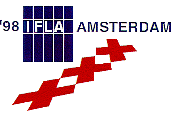
As of 22 April 2009 this website is 'frozen' in time — see the current IFLA websites
This old website and all of its content will stay on as archive – http://archive.ifla.org

As of 22 April 2009 this website is 'frozen' in time — see the current IFLA websites
This old website and all of its content will stay on as archive – http://archive.ifla.org





Because art library collections very often contain more non-traditional textual and visual materials we may also have the duties of curator or publicist. This role helps to identity and to bring forth information imbedded in research materials such as publications, correspondence files, expedition reports and photographs.
Art Librarians acting as curators or publicists for their respective collections is a frequently discussed topic in the United States. For instance, at the most recent ARLIS/NA conference in Philadelphia I co-moderated a session with Rosemary Haddad from the Canadian Centre for Architecture entitled "The Art Librarian as Curator". This well attended session featured four speakers representing the libraries from Northwestern University in Illinois, Broward County Library's Bienes Center for the Literary Arts in Florida, Free Library of Philadelphia and the American Museum of Natural History. Reports of these talks have appeared in a recent issue of Art Documentation published by the Art Libraries Society of North America.
To trace the way one functions as a curator or publicist specific examples can be drawn from the Brooklyn Museum's Library and Archival collection. This is a particularly good point in time to have this discussion since 1998 is the 175th anniversary of the founding of the museum as a library. To celebrate this anniversary I have functioned both as a curator and publicist and have developed a series of events focused on the richness of the research collections which includes publications, exhibitions and lectures. The primary goal of this celebration is to publicize these collections which are usually hidden from view with an eye towards fundraising to support needed renovation as well as acquisitions. The lecture series, complemented with a series of small installations of related research items in display cases, has been developed to highlight items from the collection which serve to document particular topics. The lecture series has included talks on the Museum's landmark exhibitions of African art, the relationship the Museum has had with the design world, sources of inspiration for contemporary design from Egyptian books and a survey of artists' books from the Library collection by Clive Phillpot. The series continues this fall with lectures on pochoir plates and documentary photographs from Mexico taken around the late 1880's.
We also had the welcome opportunity to install some of the vintage fashion sketches from the Library collection at the Henri Bendel department store located at 5th avenue and 56th street in Manhattan. These sketches were drawn from a collection of over 9,000 fashion sketches which document everything Henri Bendel created or imported from 1912 to 1950. With a highly visible location, this installation gave us a welcome opportunity to show some of these beautiful sketches to the public who came to the store. The installation pointed to the important contribution the store has made to the world of American fashion over the years and allowed us to hold a fundraising event at the store to highlight the need for funds to preserve these collections. We were also able to include several artists' books from the Library collection in the exhibit entitled "The Book as a Work of Art" a the Queens Public Library in New York.
In addition to lectures, exhibitions and events, we planned a new brochure to describe the research collections and to serve also as development tool. Articles on the collection as a whole, as well as on specific parts of the collection, were written and submitted to several publications. With the library staff of the Brooklyn Public Library, we were able to develop a website devoted to the history of our respective institutions. The address is http://www.brooklynpubliclibrary.org then click on "Neighbors Celebrate 200 Years". We look forward to more collaborative projects with other libraries such as digital projects focused on special collections such as the fashion sketches.
We also are planning to continue to curate and publicize the richness of the research collection. One idea we have is to reproduce and circulate images from the Culin Archival Collection to the Native American community. The Culin Archives includes photographs which document the people, places and objects that Stewart Culin, the Museum's founding Curator of Ethnology, encountered in his travels in North America from 1903 to 1912. We have found that when tribal consultants visit the Museum they usually are interested in coming to the Library to view the documentary photographs which represent their culture. We hope to make these images available to them on their reservations so they become more readily accessible.
We believe all of the above is a successful effort to publicize what can be found in our collection and to help raise the needed funds to care for the research materials. While a strain on our time, I feel that our role as curator and publicist is well worth the effort. The result has been a heightened recognition both inside my institution as well as outside that the collections are important and well worth preserving for future use. I encourage you to consider taking on this role as well.